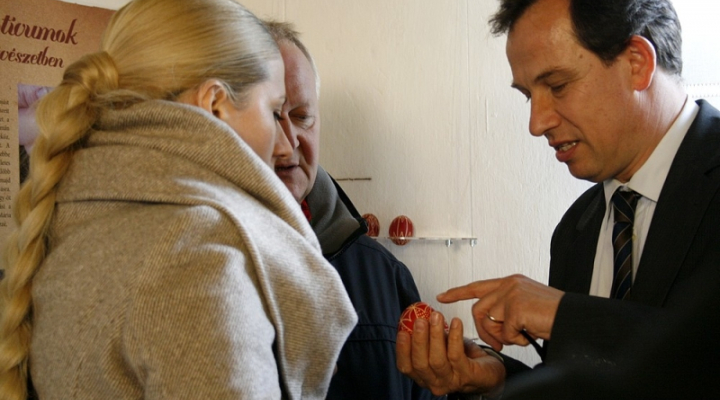Thousand-year-old motifs in the Fészek Tájház regional house
On Saturday, 12 April the he Fészek Tájház regional house from Siculeni hosted an exhibition presenting the decorative art of Csangos from the Ghimeș area and of the Szeklers from Bukovina. The exhibition also included a collection of Easter eggs, the painting technique of which could be learnt by visitors, too.
A part of the exhibits offering a perspective upon the thousand-year-old motifs kept intact by the Szeklers from Bukovina were lent to the Fészek Tájház by the Völgységi Museum from Bonyhád. Visitors can get acquainted with the rich universe of patterns on the exhibited folk clothes as well as on the photos of textiles, embroideries, pillow covers, shirts, vests and fur coats. In the other room of the regional house visitors could inspect an interior from Ghimeș, as well as a set of Easter eggs painted by Gyöngyvér Bíró.
The exhibition was opened on 12 April 2014 by MEP Csaba Sógor and Angéla Ferencz, the director of the Cultural Centre of Harghita County. Schoolteacher Hajnal Galaczi sang songs from Bukovina.
In his opening speech Csaba Sógor talked about the importance of protecting folk traditions, quoting from the book of Gábor Lükő, The Shapes of the Hungarian Soul: “Folk art, folk literature and folk music live together in the soul of the people from villages, it was us, city dwellers, who separated them. Analysis has its merit; the mechanism of a watch can only be known by the one who opens it, but he must also be sure that he is capable to put the pieces back to their place.”
“Gábor Lükő described in 1942 something for which half a century was needed to be really understood: walking into the “clean room” he didn’t just see sculpted decorations, but thousand-year-old motifs, feeling himself close to those who many-many years ago lived, worked and raised families there. Here, in this small dwelling, we can also feel close to our ancestors”, said Sógor.
In her speech, Angéla Ferencz talked about the void-filling role of the Fészek Tájház: “I would have been a lot more proud if, when presenting the monument of Siculeni to my Szekler friends from Bukovina, I had been able to show them this place” said the director of the Cultural Centre of Harghita County. In this sense she also added that the appreciation of Szeklerland depends to a large extent on the creative instruments though which we try to present as much as possible of the inhabitants of this region.
The exhibition was opened on 12 April 2014 by MEP Csaba Sógor and Angéla Ferencz, the director of the Cultural Centre of Harghita County. Schoolteacher Hajnal Galaczi sang songs from Bukovina.
In his opening speech Csaba Sógor talked about the importance of protecting folk traditions, quoting from the book of Gábor Lükő, The Shapes of the Hungarian Soul: “Folk art, folk literature and folk music live together in the soul of the people from villages, it was us, city dwellers, who separated them. Analysis has its merit; the mechanism of a watch can only be known by the one who opens it, but he must also be sure that he is capable to put the pieces back to their place.”
“Gábor Lükő described in 1942 something for which half a century was needed to be really understood: walking into the “clean room” he didn’t just see sculpted decorations, but thousand-year-old motifs, feeling himself close to those who many-many years ago lived, worked and raised families there. Here, in this small dwelling, we can also feel close to our ancestors”, said Sógor.
In her speech, Angéla Ferencz talked about the void-filling role of the Fészek Tájház: “I would have been a lot more proud if, when presenting the monument of Siculeni to my Szekler friends from Bukovina, I had been able to show them this place” said the director of the Cultural Centre of Harghita County. In this sense she also added that the appreciation of Szeklerland depends to a large extent on the creative instruments though which we try to present as much as possible of the inhabitants of this region.











